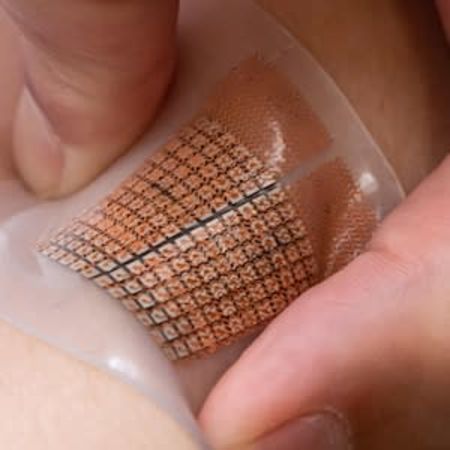Engineers at the University of California San Diego have developed a soft and stretchy ultrasound patch that can be worn on the skin to monitor blood flow through major arteries and veins inside a person's body. The patch can continuously monitor blood flow as well as blood pressure and heart function, in real time. Wearing such a device could make it easier to identify cardiovascular problems early on.
The patch can be worn on the neck or chest. It can sense and measure cardiovascular signals as deep as 14 centimetres inside the body in a non-invasive manner. And it can do so with high accuracy. It can thus provide a comprehensive and accurate picture of what's going on in deep tissues and critical organs like the heart and the brain.
Another innovative feature of the patch is that the ultrasound beam can be tilted at different angles and steered to areas in the body that are not directly underneath the patch. This is a first in the field of wearables. Most wearables that are used today only monitor areas right below them. But this patch can probe areas that are wider than the device's footprint.
The patch is made up of a thin sheet of flexible, stretchable polymer that adheres to the skin. Embedded on the patch is an array of millimetre-sized ultrasound transducers. Each is individually controlled by a computer. This type of array is known as an ultrasound phased array.
The phased array offers two main modes of operation. In one mode, all the transducers can be synchronised to transmit ultrasound waves together, which produces a high-intensity ultrasound beam that focuses on one spot as deep as 14 centimetres in the body. In the other mode, the transducers can be programmed to transmit out of sync, which produces ultrasound beams that can be steered to different angles.
The phased array consists of a 12 by 12 grid of ultrasound transducers. When electricity flows through the transducers, they vibrate and emit ultrasound waves that travel through the skin and deep into the body. When the ultrasound waves penetrate through a major blood vessel, they encounter movement from red blood cells flowing inside. This movement changes or shifts how the ultrasound waves echo back to the patch--an effect known as Doppler frequency shift. This shift in the reflected signals gets picked up by the patch and is used to create a visual recording of the blood flow. This same mechanism can also be used to create moving images of the heart's walls.
For many people, blood flow is not something that is measured during a regular visit to the physician. It is usually assessed after a patient shows some signs of cardiovascular problems, or if a patient is at high risk. The standard blood flow exam itself can be time consuming and labor intensive. This patch is much easier to use. You simply connect it to the skin and read the signals. It's also not operator dependent, hence there is no extra work or burden to the technicians, clinicians or patients.
In tests, the patch performed as well as a commercial ultrasound probe used in the clinic. It accurately recorded blood flow in major blood vessels such as the carotid artery, which is an artery in the neck that supplies blood to the brain. Having the ability to monitor changes in this flow could, for example, help identify if a person is at risk for stroke well before the onset of symptoms.
However, the patch still has a long way to go before it is ready for the clinic. Currently, it needs to be connected to a power source and benchtop machine in order to work but the research team is working on integrating all the electronics on the patch to make it wireless.
Source: University of California San-Diego
Image Credit: Nature Biomedical Engineering



























